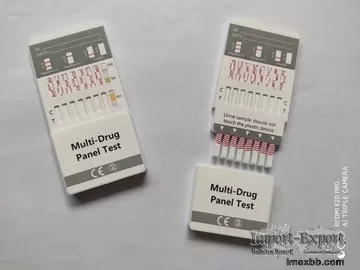 |
Home > Offers to Sell > Health & Beauty > Medical Supplies > Examination & Testing Instruments
| Contact: | Mr. Jerry Meng |
|---|---|
| Company: | Orient New Life Medical Co.,Ltd. |
| 12F,Guting Building,Hefeng Creative Square,No.495 Jiangdong North Road,Ningbo,Zhejiang, China | |
| Ningbo 315000 | |
| China | |
| Phone: | 86-130-22602586 |
| Fax: | 86-573-82033098 |
| E-Mail: | |
| Date/Time: | 4/20/23 9:00 GMT |
16 Panel Self Testing Drug Kits 15 Urine Drug Test Plus Adulterant Strip
16 panel Drug Abuse test kit 15 urine drug test plus adulterant strip
Intended Use
The Multi-drug Rapid Test Panel (Urine) is rapid chromatographic immunoassays for
the qualitative and simultaneous detection up to sixteen of the following drugs in
human urine. The designed cutoff concentrations for these drugs are as follows:
Test Cut-off (ng/mL)
AMP(Amphetamine) 500
THC(Marijuana) 50
COC (Cocaine) 200
PCP(Phencyclidine) 25
MOR(Morphine) 200
MET(Methamphetamine ) 500
MTD(Methadone) 300
BZO(Oxazepam) 200
BUP(Buprenorphine) 5
ETG(Ethylglucoronide) 1000
TML(Tramadol) 100
COT(Cotinine) 300
FYL(Fentanyl) 100
OXY (Oxycodone) 100
PGB (Pregabalin) 500
Adulteration ( Oxidants,Specific Gravity,pH) /
Principle
The Multi-drug Rapid Test Panel (Urine) is one-step immunoassay in which chemically
labeled drugs (drug-protein conjugates) compete for limited antibody binding sites
with drugs which may be present in urine. The test panel contains membrane strips
which are pre-coated with drug-protein conjugates on the test band(s). Each strip,
the drug antibody-colloidal gold conjugate pad is placed at one end of the
membrane. In the absence of drug in the urine, the solution of the colored
antibody-colloidal gold conjugate move along with the sample solution upward
chromatographically by capillary action across the membrane to the immobilized
drug-protein conjugate zone on the test band region. The colored antibody-gold
conjugate then attach to the drug-protein conjugates to form visible lines as the
antibody complex with the drug conjugate. Therefore, the formation of the visible
precipitant in the test zone occurs when the test urine is negative for the
drug.When the drug is present in the urine, the drug/metabolite antigen competes
with drug-protein conjugate on the test band region for the limited antibody. When
a sufficient concentration of the drug is present, it will fill the limited
antibody binding sites. This will prevent attachment of the colored antibody (drug-
protein conjugate)-colloidal gold conjugate to the drug-protein conjugate zone on
the test band region. Therefore, absence of the color band on the test region
indicates a positive result.A control band with a different antigen/antibody
reaction is added to the immunochromatographic membrane strip at the control region
(C) to indicate that the test has performed properly. This control line should
always appear regardless of the presence of drug or metabolite. If the control line
does not appear the test panel should be discarded.
Adulteration is the tampering of a urine specimen with the intention of altering
the test results. The use of adulterants can cause false negative results in drug
tests by either interfering with the screening test and/or destroying the drugs
present in the urine. Dilution may also be employed in an attempt to produce false
negative drug test results.One of the best ways to test for adulteration or
dilution is to determine certain urinary characteristics such as pH, and Specific
Gravity and to detect the presence of Oxidants in urine.
INTERPRETATION OF RESULTS
NEGATIVE:* A colored line appears in the Control region (C) and colored lines
appears in the Test region (T). This negative result means that the concentrations
in the urine sample are below the designated cut-off levels for a particular drug
tested.
*NOTE: The shade of the colored lines(s) in the Test region (T) may vary. The
result should be considered negative whenever there is even a faint line.
POSITIVE: A colored line appears in the Control region (C) and NO line appears in
the Test region (T). The positive result means that the drug concentration in the
urine sample is greater than the designated cut-off for a specific drug.
INVALID: No line appears in the Control region (C). Insufficient specimen volume or
incorrect procedural techniques are the most likely reasons for Control line
failure. Read the directions again and repeat the test with a new test card. If the
result is still invalid, contact your manufacturer.
Cross Reactivity
A study was conducted to determine the cross-reactivity of the test with compounds
in either drug-free urine or drug positive urine containing, Amphetamine,
Barbiturates, Benzodiazepines, Buprenorphine, Cocaine, Marijuana, Methadone,
Methamphetamine, Methylenedioxymethamphetamine, Morphine, Tramadol , Methaqualone,
Ketamine ,Phencyclidine, Propoxyphene or Tricyclic Antidepressants. The following
compounds show no cross-reactivity when tested with the Multi-Drug Rapid Test Panel
with Adulteration at a concentration of 100 µg/mL. Visual interpretations occurred
at 5 minutes after specimen application. Results are presented in table below.
SOURCE: Import-Export Bulletin Board (https://www.imexbb.com/)
Similar Products:Not exactly what you are looking for? Post an Offer to Buy!
![]()
© 1996-2010 IMEXBB.com. All rights reserved.
|
|
|






